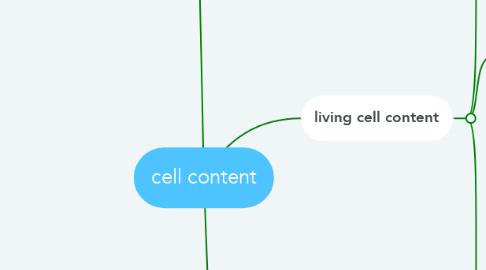
1. non-living cell content
1.1. ergastic cell content
1.1.1. stratch
1.1.1.1. chracteristic granules
1.1.1.1.1. size
1.1.1.1.2. shape
1.1.1.1.3. hilum
1.1.1.1.4. striations
1.1.1.1.5. aggregation
1.1.1.1.6. frequency
1.1.1.2. abundant in ground structures
1.1.2. protein
1.1.2.1. in fruit and seeds
1.1.2.2. as aleurone grains
1.1.2.2.1. grystalloid
1.1.2.2.2. globoid
1.2. the carbohydrates inulin and sinstrin
1.2.1. as needle-like crystals and fixed oil appears as globules
1.2.2. occurs mainly in seeds and fruits
1.3. waste products
1.3.1. ca(ox)
1.3.1.1. various crystalline shapes
1.3.1.1.1. prisms
1.3.1.1.2. clusters
1.3.1.1.3. raphides (form fronm needles)
1.3.1.1.4. microcrystal
1.3.1.2. size
1.3.1.2.1. small (<5micron)
1.3.1.2.2. medium
1.3.1.2.3. large (>100 micron)
1.3.1.3. frequency
1.3.1.3.1. rare
1.3.1.3.2. frequent
1.3.1.3.3. numerous
1.3.2. ca(co3)
1.3.2.1. amorphous masses or cystoliths
1.3.2.2. incrusted into cell walls particularly those of trichomes
1.3.3. tannin
1.3.3.1. deposited in dead areas of tissues suc as
1.3.3.1.1. cork
1.3.3.1.2. heartwood
1.3.3.1.3. special tannin cells
2. living cell content
2.1. cellulose walls
2.1.1. parenchyama (basic cell)
2.1.1.1. packing material
2.1.2. modified parenchyma
2.1.2.1. with chloroplasts (chlorenchyma)
2.1.2.1.1. photosynthesis
2.1.2.2. food reserves
2.1.2.2.1. position
2.1.2.2.2. function
2.1.2.3. surrounded by large air spaces (spongy mesophyll and aeranchyma)
2.1.2.3.1. aeration
2.1.2.3.2. aquatic plants buoyancy
2.1.2.4. containing mucilage
2.1.2.4.1. water storage
2.1.2.5. modefied cell structure e.g. root hair
2.1.2.5.1. water absorpation
2.1.3. collenchyma
2.1.3.1. formation
2.1.3.1.1. basic cell with secondary wall of cellulose or hemicellulose
2.1.3.2. function
2.1.3.2.1. mechanical support
2.1.4. sieve tubes (phloem)
2.1.4.1. food conduction
2.1.5. some fibers
2.2. superised walls
2.2.1. cork produced by cork cambium(phellogen)
2.2.1.1. protection
2.2.1.2. deposit area for waste product e.g. tannin
2.2.2. endodermis-innermost layer of cortex of certain stems and all primary roots ,radial or radial and inner tangential walls only suberised
2.2.2.1. water barrier
2.3. lignified walls
2.3.1. sclereids (stone cells)
2.3.1.1. usually isodiametric structures
2.3.1.2. function
2.3.1.2.1. mainly mechanical support
2.3.1.2.2. in fruits and seeds for protection
2.3.2. fibers
2.3.2.1. forming
2.3.2.1.1. usually elognated structure
2.3.2.1.2. not always lignified
2.3.2.2. function
2.3.2.2.1. mechanical support
2.3.3. xaylem vessels
2.3.3.1. forming
2.3.3.1.1. tracheids,tracheidial vessels
2.3.3.1.2. not lways lignified
2.3.3.2. function
2.3.3.2.1. water coduction
2.3.4. lignified parenchyma
2.3.4.1. xylem-herbaceous & woody stems
2.3.4.1.1. packing
2.3.4.2. medullary ray-secondary roots
2.3.4.2.1. food storage
2.3.4.3. pith-herbaceous & woody stems
2.3.4.3.1. mechanical support
2.3.4.4. reticulate (fruits and seeds)
2.3.4.4.1. mechanical support
2.3.5. endocarp (inner epidermis of pericarp)
2.3.5.1. not always lignified
2.3.5.2. occasionally food storage
2.3.5.3. protection of seeds
2.3.6. seed testa (one of the layers of the inner or the outer testa)
2.3.6.1. maybe combined with pigement
2.3.6.2. protection of embryo
3. different type of cells and tissue
3.1. paranchyma
3.1.1. usually isodiametric
3.1.2. cellulose walls
3.1.3. intercellular spaces
3.2. collenchyma
3.2.1. slightly elongated
3.2.2. walls unevently thickened with cellulose
3.2.3. thickness is usually greatest at the corner
3.3. scalerenchyma (fibers)
3.3.1. much elongated
3.3.2. with tapering ends
3.3.3. dead when mature
3.3.4. characterstics
3.3.4.1. thick walls
3.3.4.2. narrow lumen
3.3.4.3. absence of intercelluler spaces
3.4. xylem vessels
3.4.1. different patterns thicking
3.4.1.1. asannular
3.4.1.1.1. ofring
3.4.1.2. spiral
3.4.1.2.1. spiral
3.4.1.3. reticulate or pitted
3.4.1.3.1. network or pits
3.4.1.4. scalariform
3.4.1.4.1. when the pits are transversely extended the thicking
3.5. sieve tube and companion cells
3.5.1. sieve tube are
3.5.1.1. elongated
3.5.1.2. thin walled cells
3.5.1.3. with perforated end wals referred to sieve plate
3.5.2. companion cells forming
3.5.2.1. may be
3.5.2.1.1. smooth
3.5.2.1.2. striated
3.5.2.2. in contact each sieve arepresent tube one or more of cells triangle combanion cells with dense contents
3.6. dermal tissue and epidermal characters
3.6.1. the surface of all primary plant organs is coverd by alayer of epidermals
3.6.2. usually one cell deep except in aquatic plants a cellulosic epidermals is covered by cutical of varying thickness
3.6.3. shape
3.6.3.1. monocotyledonous plant organs
3.6.3.1.1. elongated
3.6.3.1.2. stems
3.6.3.1.3. leaf midribsand petiols
3.6.3.2. dicotyledonous plant organs
3.6.3.2.1. polygonal
3.6.3.3. common in all
3.6.3.3.1. no air space between the cells
3.6.3.3.2. certain cells are modified to form

